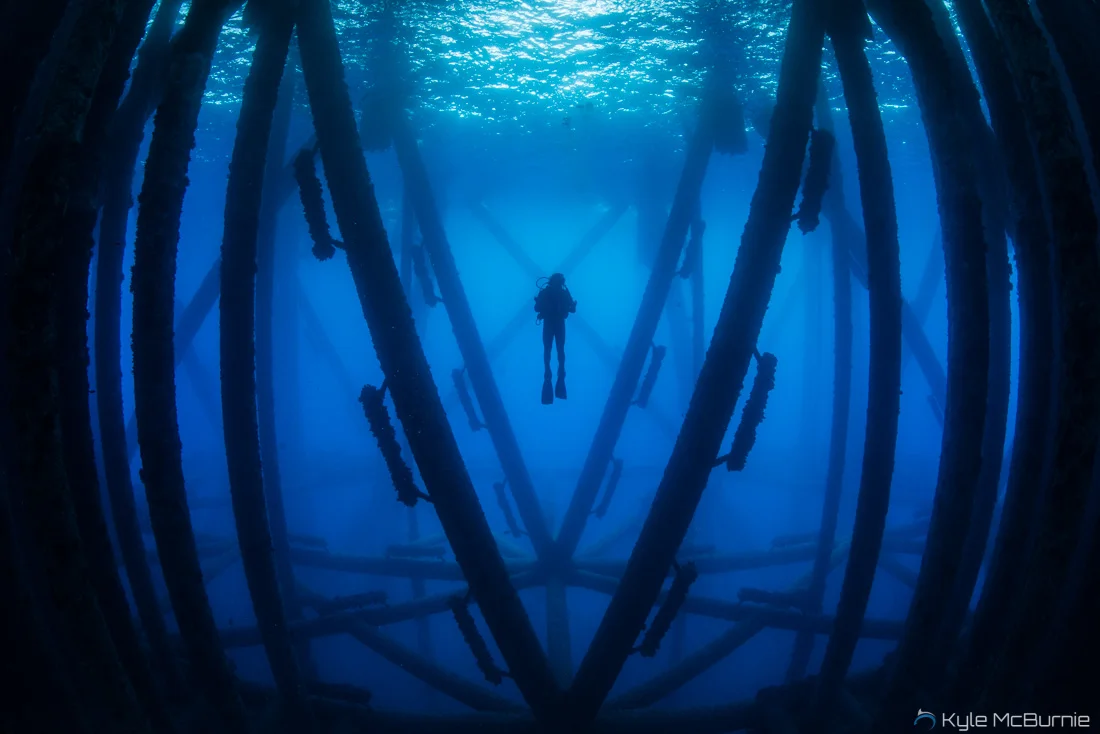From Malaysia to the Gulf of Mexico, the Blue Latitudes Foundation (BLF) has explored offshore oil and gas (O&G) platforms around the world. This trip, however, was a little closer to home. In September 2021, the BLF assembled a crew with varied backgrounds in science, art, and underwater videography to dive the offshore O&G platforms in California. For me, it was an especially exciting day, as this trip would mark my very first oil platform dive- an experience I had been looking forward to since starting my position as BLF’s Program Coordinator.
BLF Program Coordinator Jacqueline Rosa ready for her first oil platform dive.
On a quiet morning in San Pedro, we gathered to load the dive boat with gear, tanks, and our Deep Trekker DTG3 remotely operated vehicle (ROV). Captain Jim Simmerman slowly cruised out of Los Angeles Harbor, then headed South towards the Beta Oil Field, an area that includes Platforms Ellen, Elly, Eureka, and Edith. While underway, divers assembled gear, reviewed dive plans, and readied the camera equipment.
Aboard the Giant Stride: (from left to right) Jacqueline Rosa (BLF), Conner Jainese (University of California Santa Barbara), Katelin Seeto (University of California Santa Barbara), Grace Young (Google X), Amber Sparks (BLF), Ami Everett (Blue Latitudes, LLC), and Jacqueline Lehr (Underwater Camera Operator).
Platforms Ellen and Elly – connected by a catwalk above the water- served as our first dive site. Installed in 1980, both platforms are situated in about 260 feet (ft.) of water and are located approximately 9 miles from Huntington Beach, CA. Platform Elly processes production from Platforms Ellen and Eureka, both drilling platforms, and provides water and electricity to each.
Captain Jim idled alongside Platform Elly as divers stepped into the water, two by two. Kicking through the strong surface current, my dive buddy and I reached the corner piling of the platform to use as a guide for our descent. As we descended, a group of curious sea lions circled us, and schools of kelp bass and blacksmith swam overhead. While towards the surface we saw a steel giant, the moment we dove in we were met with a vibrant community of fish and invertebrates. Composed of steel beams, the platform structure was encrusted with an array of marine organisms, including bright pink anemones, blue mussels, and countless brittle stars. Once we arrived at the first crossbeam, located at 40 ft., we swam through the complex structure and observed garibaldi and sheephead. From this position under the platform, crossbeams and pylons reached out in every direction, reminding me of how these structures earned the nickname ‘steel giants’.
Back on the dive boat for a surface interval, we exchanged stories and warmed up while transiting to Platform Eureka, our second dive site. Standing tall in 700 ft. of water, Eureka is the deepest platform accessible to recreational divers in California. While offshore conditions were rough earlier in the day, the wind and current had since calmed, providing an opportunity to launch our DTG3 ROV. Capable of exploring depths up to 656 ft, the DTG3 ROV is a 19 lb. underwater robot with a high-definition camera and built-in lights. Operated by Amber Sparks, BLF co-president, and Ami Everett, Marine Scientist of Blue Latitudes, LLC, the DTG3 followed divers as they descended into the blue. My dive buddies and I watched the small underwater robot survey Eureka’s shallowest crossbeam at 50 ft. Other divers harvested scallops growing on the pylons, as schools of fish gathered below to collect the scraps. While some species, such as rockfish, utilize O&G platforms as juveniles then move into deeper water, other species find permanent homes along the steel beams.
The Deep Trekker DTG3 remotely operated vehicle (ROV) ready for deployment.
BLF Co-President, Amber Sparks, and Marine Scientist, Ami Everett, take a selfie with Platform Eureka.
As we ascended to the surface, we were once again visited by a group of inquisitive sea lions. My first platform dive trip was in the books, and it did not disappoint. A closer look at life below O&G platforms provided a deepened understanding of how these complex structures support unique communities of marine life.













